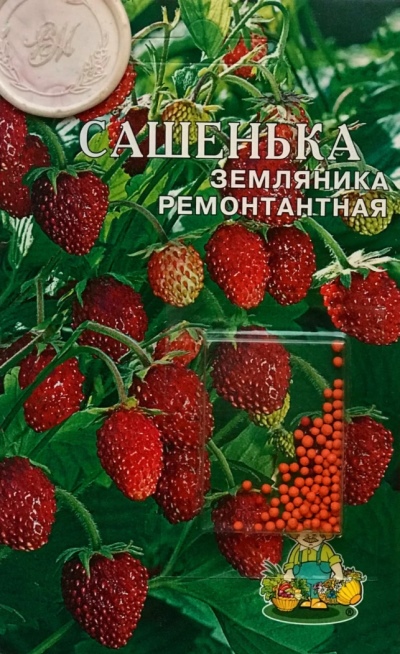
- Taste: sweet
- Weight: 3-4 gr
- Yield rate: high
- Repairability: Yes
- Ripening terms: early
- Appointment: fresh consumption, processing (juice, jam, jam, etc.)
- Description of the bush: globular, well leafy
- Berry color: Dark red
- Winter hardiness: winter hardy
- Scent: saturated
Strawberry Sasha is a remontant early-maturing variety. It is considered quite resistant to various diseases and pests. And also this variety is resistant to temperature extremes.
Description of the variety
This variety has a well-leafy globular bush. Ripe fruits can be eaten fresh. And they are also often used for processing, including making jam and juice.
Ripening terms
The first shoots are usually formed in 2-3 weeks. Moreover, when sowing seed in March, the seedlings should be transplanted 2-3 times. This variety belongs to the group of remontants. They bear fruit not only in summer, but also in autumn.
Yield
This strawberry variety has a fairly high yield level. From one bush, you can collect about 2 kilograms of ripe fruits.
Berries and their taste
The berries of this strawberry variety have a rich dark red color. The mass of one ripe fruit is approximately 3-4 grams. They taste rather sweet, have a rich and pleasant aroma. The berry pulp is firm and juicy.
Growing features
Sasha's strawberry is considered a frost-resistant species. But at the same time, she still needs to apply special protective measures closer to the onset of the winter period.




Site selection and soil preparation
To begin with, you need to determine exactly where the seedlings will be planted.The best option is a spacious area fully illuminated by sunlight and protected from strong gusts of wind. Sasha's strawberries are not very demanding on the quality of the soil, but still, on fertile black soil, the yield is usually higher.
After a suitable landing site has been selected, you should begin to prepare the soil. It is best to immediately apply manure and fertilizers with potassium sulfate and superphosphate. At the same time, when planting, the distance should be observed so that the growing plants do not interfere with each other. Between the bushes it is better to make a distance of 25-30 cm. Between individual rows, you can make a distance of 55-60 centimeters.

Pollination
The strawberry variety Sasha belongs to the self-pollinated species. In this case, the transfer of pollen to the stigma is carried out from one flower. Pollen carriers in the middle of a flower bud are most often small drops of dew, as well as small insects that live in flowers. In some plants, the pollination process is carried out in the bud and completely eliminates cross-pollination.
Top dressing
For such strawberries, a mullein solution may be the best option. Moreover, it is recommended to make it after the snow melts. The liquid is applied under each bush (about 0.5 liters per bush).
Potash nitrate is also a good option. In this case, the substance should be applied in May. Each bush is poured with a liquid under the root. Moreover, for each such plant, approximately 0.5 liters of the finished composition will be needed.
Wood ash is sometimes used as well. It is best used at the end of the summer period. Such a nutritious dressing is scattered on the root zone of the plants. Later, all this is carefully loosened.

One of the important techniques in strawberry care is feeding. Regular fertilization guarantees a rich harvest. There are several different ways to feed strawberries, and each of them is designed for a specific period of plant development. During flowering, fruiting and after it, feeding should be different.
Frost resistance and the need for shelter
This type of strawberry is considered to be quite hardy. At the same time, it will be necessary to cover the strawberries during periods of snowless winters with severe frosts and low temperatures.
In regions with snowy winters and light winds, additional cover for such vegetation is not necessary. After all, snow masses are able to protect plantings from severe frosts.

Diseases and pests
Sasha's strawberry has good resistance to various diseases and pests. But at the same time, it is still sometimes exposed to the negative effects of root rot. As a rule, it occurs due to excessive waterlogging of the soil. And also various fungal infections may appear.
Strawberries can also suffer from powdery mildew. To prevent the destruction of the crop, preventive measures should be taken in a timely manner. It is recommended to carry out periodic treatments using Bordeaux liquid.
And also when planting, you should select places next to fennel, dill, onions or garlic. This vegetation allows you to scare off a variety of pests from strawberries.
Make sure that the beds are not overgrown with harmful weeds. Make sure that no dry old foliage lies on the ground. It can also harm plants. Old and diseased plantings should be removed immediately.

Strawberries are often subject to many dangerous diseases that can seriously undermine its condition. Among the most common are powdery mildew, gray mold, brown spot, anthracnose, and verticillosis. Before buying a variety, you need to inquire about its disease resistance.
Reproduction
It should be remembered that Sasha belongs to the hybrid species, therefore it is simply not possible to collect seeds from ripe fruits. The new plant will not be able to inherit all the traits of this variety. For reproduction, it is better to purchase seed from breeders. And also sometimes this strawberry is bred with rosettes from the mustache. In the latter case, it is better to use sockets of the first or second order. They are considered the most powerful.



















































































